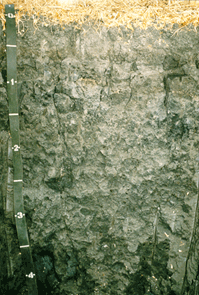
Figure 12 - Clear Lake
soils with deep vertical cracking and slickensides. Scale is in feet.
Clear Lake Series
The Clear Lake series consists of very deep, poorly drained soils on basin floors. These soils formed in alluvium derived from mixed sources. Slope ranges from 0 to 2 percent. The mean annual precipitation is 14 to 20 inches, and the mean annual temperature is 57 to 62 degrees F.
Taxonomic class: Fine, smectitic, thermic Xeric Endoaquerts

Figure 12 - Clear Lake
soils with deep vertical cracking and slickensides. Scale is in feet.
Typical Pedon
Clear Lake clay, 0 to 1 percent slopes, occasionally flooded, cropland. When described on October 25, 1988, the soil was dry to 10 inches and moist below with a water table at 6 feet.
Ap1—0 to 4 inches; gray (10YR 5/1) clay, very dark gray (10YR 3/1) moist; medium fine subangular blocky structure; very hard, firm, very sticky and very plastic; many very fine roots; common very fine and many fine tubular pores; slightly acid (pH 6.1); clear smooth boundary.
Ap2—4 to 10 inches; gray (10YR 5/1) clay, very dark gray (10YR 3/1) moist; moderate fine subangular blocky structure; very hard, firm, very sticky and very plastic; common very fine roots; many very fine tubular pores; common fine prominent olive brown (2.5Y 4/4) masses of iron accumulation; slightly acid (pH 6.1); clear wavy boundary.
Bss1—10 to 20 inches; gray (10YR 5/1) clay, very dark gray (10YR 3/1) moist; strong very coarse prismatic structure; very hard, firm, very sticky and very plastic; common very fine roots; many very fine tubular pores; many intersecting slickensides; common fine prominent light olive brown (2.5Y 5/4) masses of iron accumulation; neutral (pH 6.9); gradual wavy boundary.
Bss2—20 to 34 inches; gray (10YR 5/1) clay, very dark gray (10YR 3/1) moist; moderate medium prismatic structure; very hard, firm, very sticky and very plastic; common very fine roots; many very fine tubular pores; many intersecting slickensides; common fine prominent light olive brown (2.5Y 5/4) masses of iron accumulation; slightly alkaline (pH 7.4); gradual wavy boundary.
Bss3—34 to 48 inches; gray (10YR 5/1) clay, dark grayish brown (2.5Y 4/2) moist; moderate coarse angular blocky structure; very hard, firm, very sticky and very plastic; few very fine and fine roots; common very fine tubular pores; many intersecting slickensides; common coarse prominent light olive brown (2.5Y 5/4) masses of iron accumulation; slightly alkaline (pH 7.8); clear smooth boundary.
Bssk1—48 to 60 inches; gray (5Y 5/1) clay, dark gray (5Y 4/1) moist; moderate medium angular blocky structure; very hard, firm, very sticky and very plastic; few very fine roots; common very fine tubular pores; many intersecting slickensides; common medium distinct light brownish gray (2.5Y 6/2) masses of iron accumulation; strongly effervescent; moderately alkaline (pH 7.9); clear smooth boundary.
Bssk2—60 to 80 inches; grayish brown (2.5Y 5/2) clay, dark grayish brown (2.5Y 4/2) moist; moderate medium angular blocky structure; very hard, firm, very sticky and very plastic; few very fine roots; common very fine tubular pores; many intersecting slickensides; strongly effervescent; common large distinct light olive brown (2.5Y 5/3) masses of iron accumulation; moderately alkaline (pH 8.0); clear smooth boundary.
Type location: Colusa County, California; located about 7 1/2 miles northeast of Dunnigan, California in an unsectionalized area, 1710 feet west and 525 feet south of the southwest corner of section 6, T. 13 N., R. 1 E., MDB&M; 38 degrees, 59 minutes, 45 seconds north latitude and 121 degrees, 55 minutes, 15 seconds west longitude; USGS Dunnigan, California topographic quadrangle.
Range in Characteristics
The mean annual soil temperature is 63 to 65 degrees F. The soil temperature is above 47 degrees F. the entire year. The soil moisture control section, 6 to 17 inches, is dry in all parts from May 15 to October 31 unless irrigated and is moist in some or all parts from November 1 to May 15. The weighted average clay content of the textural control section ranges from 40 to 60 percent clay.
The Ap horizon is 10YR 5/1, 4/1, 3/1; 5Y 5/1; N 3/0. Moist color is 10YR 3/1; 5Y 3/1; N 2/0. Texture is clay. Effervescence is slight to violent. Some pedons have free carbonates in seams and dispersed throughout the matrix. Reaction is slightly acid to slightly alkaline.
The Bss and Bssk horizon is 10YR 5/1; 2.5Y 5/2; 5Y 6/2, 5/2, 5/1, 4/1; N 5/0. Moist color is 10YR 4/4, 3/2, 3/1; 2.5Y 4/2, 3/2; 5Y 5/3, 4/3, 4/2, 4/1, 3/2, 3/1; N 3/0, 2/0. Texture is clay. Reaction is neutral to strongly alkaline. Effervescence is slight to violent. Some pedons have free carbonates in seams and dispersed throughout the matrix. Manganese concretions and iron accumulations are found in some pedons.